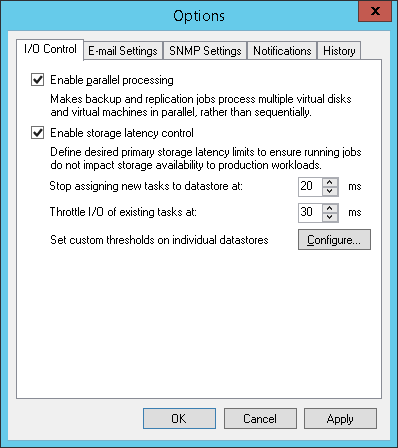 This is an archive version of the document. To get the most up-to-date information, see the current version.
This is an archive version of the document. To get the most up-to-date information, see the current version.Data Processing Modes
Veeam Backup & Replication can process VMs in the job and VM disks in parallel or sequentially. The data processing mode is a global setting: it takes effect for all jobs configured on the backup server.
Parallel Data Processing
By default, Veeam Backup & Replication works in the parallel data processing mode. If a job includes several VMs or VMs in the job have several disks, VMs and VM disks are processed concurrently.
Parallel data processing optimizes the backup infrastructure performance and increases efficiency of resource usage. It also reduces the time of VM snapshots being open and mitigates the risk of long snapshot commit.
Veeam Backup & Replication uses parallel processing for the following jobs:
- Backup jobs
- Backup copy jobs
- Replication jobs

If you choose to process VM data in parallel, check task limitation settings for components in your backup infrastructure and make sure that these components have sufficient compute resources to support parallel processing.
Task limitation settings define the number of tasks that the backup infrastructure component can perform concurrently, or at the same moment. The maximum number of concurrent tasks that a backup proxy or repository can perform depends on the number of CPU cores available on this backup proxy or backup repository. It is strongly recommended that you assign task limitation settings using the following rule: 1 task = 1 CPU core. For example, if a backup proxy has 4 CPU cores, it is recommended that you limit the number of concurrent tasks for this backup proxy to 4.
Task limits specified for backup proxies and backup repositories influence the job performance. For example, you add a VM with 4 disks to a job and target this job at the backup proxy that can process maximum 2 tasks concurrently. In this case, Veeam Backup & Replication will create 4 tasks (1 task per each VM disk) and start processing 2 tasks in parallel. The other 2 tasks will be pending.
For more information, see Limiting Data Ingestion Rate for Backup Repositories.
|
When you limit the number of tasks for the backup repository, you should also consider the storage throughput. If the storage system is not able to keep up with the number of tasks that you have assigned, it will be the limiting factor. It is recommended that you test components and resources of your backup infrastructure to define the workload that they can handle. |

Subsequent Data Processing
If you do not want to use parallel data processing, you can disable it. In this case, Veeam Backup & Replication will process VMs and VM disks in the job one by one, sequentially.
Even if you disable parallel data processing, backup proxies and backup repositories can still process tasks from different jobs in parallel. For example:
- You set up the backup proxy to process 2 tasks simultaneously.
- You configure 2 backup jobs, each processing 1 VM with 1 disk.
When you start backup jobs, Veeam Backup & Replication will create 2 tasks and assign these tasks to the backup proxy. The backup proxy will perform these tasks in parallel.